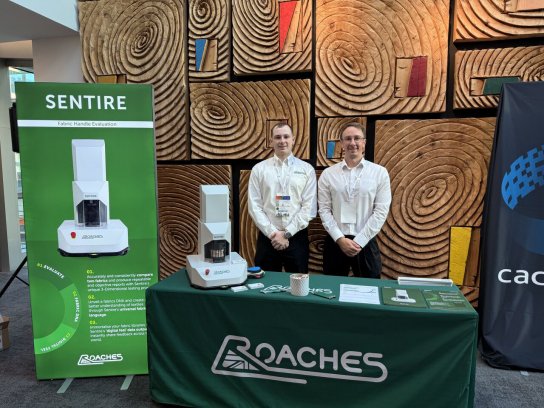
Fashion for Good launches new Good Shop theme
Data is analysed through established principles of fabric physics, delivering objective, reproducible results.

28th October 2025
Innovation in Textiles
|
Porto, Portugal
At the recent Textile Institute World Conference in Porto, Portugal, Liam O’Neill and Rob Shelton of UK-based Roaches International introduced the new Sentire system for the assessment of fabric handle.
The feel of a fabric has historically relied on subjective human judgement, challenging consistency, scalability and sustainability across global supply chains, but as the industry faces the loss of seasoned specialists and rising demands for sustainable practices, a shift towards quantifiable, standardised methodologies is needed.
“No two people will describe how a fabric feels in the same way and the lack of a common language to describe fabric tactility poses communication challenges across the complex global fashion and textile supply chain,” said O’Neill. “How do you objectively measure qualities like softness, smoothness, drape and stiffness?”
The Sentire aims to address this through four precise test methods to mimic human touch and quantifying key tactile properties. The collected data is analysed through established principles of fabric physics, delivering objective, reproducible results.
The system enables real-time quality monitoring in the production stages, enhancing responsiveness and minimising costly rework. In addition, its capacity to detect variations due to finishing, coatings or laundering provides manufacturers with actionable insights into product performance and durability.
Haptic spatial system
Roaches worked with specialists at the University of Leeds to develop the new finished fabric evaluation system which defines the tactile properties of fabrics via a haptic spatial system – similar, for example, to the way colour charts are digitally defined for colour palettes, or Tog values rate warmth.
Fabric samples are placed into the Sentire to run a series of tests which generate quantitative fabric tactile property data akin to a fingerprint for the fabric, which can then be compared against other samples and communicated digitally to partners in different locations.
“This technology has the potential to impact the supply chain in a similar way to the spectrophotometer for the communication of colour,” says O’Neill. “We had a fantastic response to the Sentire in Porto and believe its possibilities are huge. Not only can it be used to compare textile tactility globally, but we are also seeing interest from online retailers who want to accurately display the way a particular fabric drapes on the body.”

Business intelligence for the fibre, textiles and apparel industries: technologies, innovations, markets, investments, trade policy, sourcing, strategy...
Find out more